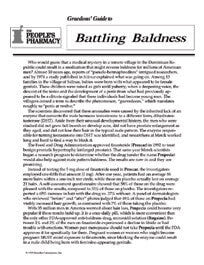Link to your individual collections by creating a new linklist in the Navigation section of the admin.
You can then have it appear here by choosing your new linklist under Customize Theme / Sidebar.

Show 1211: A Conversation With the Coronavirus Hunter
Dr. Ralph Baric has been studying coronaviruses for 35 years and is one of the world’s leading experts on these pathogens. In this interview, you will learn how the virus jumped from bats to people and how it replicates. Moreover, Dr. Baric was already studying remdesivir, a medication being utilized against this infection. He will explain how it works and why another drug may be even better. Is this coronavirus hunter optimistic that we will be able to overcome the pandemic? Get the ultimate insider’s expertise on this deadly infection.
The History of SARS-CoV-2:
Early this year, reports of a mysterious illness began emerging from China. People were coming down with severe respiratory infections in the centrally-located city of Wuhan in Hubei province. They didn’t have flu, but doctors weren't sure what they had caught. Early on, an ophthalmologist warned his colleagues that the disease was behaving like SARS, an early 21st century infection due to coronavirus. Scientists in China soon identified the pathogen as a coronavirus and sequenced its genome. While most Americans were taken by surprise, some infectious disease experts had long been dreading such an outbreak. One, Dr. Ralph Baric, is known as the coronavirus hunter.
The Coronavirus Hunter:
By mid-January, the coronavirus had a name: SARS-CoV-2. (Some scientists simply call it SARS-2.) The disease it causes had been named COVID-19 because the virus came to attention and started causing trouble late in 2019. Before long, with modern air travel and global trade, the disease was spreading around the world.
Where Did SARS-2 Come From?
The coronavirus hunter Ralph Baric and his colleagues all agree that this pathogen originated in bats. As it happens, numerous other coronaviruses that infect people have also come from from bats. Today, several of those have co-evolved so that they cause only mild illnesses generally classified as colds. However, SARS-2 only recently jumped from bats to humans, so nobody has resistance to it. As a consequence, this coronavirus could infect nearly everyone in the world.
How to Study Coronaviruses:
Because these pathogens are potentially so dangerous, the laboratories that study them need to be specially equipped. Dr. Baric’s lab at the University of North Carolina is a Biosafety Level 3. He describes what that means and the safety precautions that go into it. He also discusses what we know about the BSL3 laboratory in Wuhan.
How Does SARS-CoV-2 Spread?
This pathogen replicates itself efficiently. Moreover, it spreads very readily from one person to another, often before the infected individual even has symptoms. That is how it has caused a world-wide pandemic. The viruses can remain viable on surfaces for many hours, up to a few days, depending on the surface, the temperature, exposure to light, etc. One controversial topic is whether the SARS-CoV-2 virus is transmitted by the aerosol route. Research suggests that that is possible.
Drugs to Treat COVID-19:
As the coronavirus hunter, Dr. Baric has been involved in studying medications that might be useful against emerging coronaviruses. That’s why the Gilead drug remdesivir was ready to go into clinical trials against COVID-19 fairly quickly. Recently, investigators have seen results in placebo-controlled trials of remdesivir that have earned it the FDA’s Emergency Use Authorization.
Remdesivir is injectable, so doctors administer it only in a hospital setting. Dr. Baric’s group and their colleagues at Emory University and elsewhere have been developing an oral medication, EIDD-2801. Dr. Baric refers to it as NHC, and he explains how it is similar to and how it differs from remdesivir. (For more information, see the publication noted below.)
This Week's Guest:
Ralph Baric, PhD, is the William R. Kenan, Jr. Distinguished Professor in the Department of Epidemiology and Professor in the Department of Microbiology and Immunology of the University of North Carolina at Chapel Hill. He is a Harvey Weaver Scholar from the National Multiple Sclerosis Society and an Established Investigator Awardee from the American Heart Association. In addition, he is a World Technology Award Finalist and a fellow of the American Association for Microbiology.
He has spent the past three decades studying coronaviruses and is responsible for UNC-Chapel Hill’s world leadership in coronavirus research. For these past three decades, Dr. Baric has warned that the emerging coronaviruses represent a significant and ongoing global health threat, particularly because they can jump, without warning, from animals into the human population, and they tend to spread rapidly.
Dr. Baric's team recently published a study on EIDD-2801 as a potential treatment for SARS-CoV-2 (Science Translational Medicine, April 29, 2020). An earlier study defined the way the virus interacts with host cells (Journal of Virology, March 17, 2020).




